Biscuit Hunter
New member
I had spent a lot of time looking for a new rifle that could serve double duty as a walk-around rifle for opportunities at predators while I was scouting and shed hunting, and as an all-around hunting rifle for my son. Something light and handy, but with enough juice to use on elk. When I came across a used stainless/synthetic M7 in 260 Rem, it seemed perfect, so I snatched it up.
The first thing I did was to mount an old scope on it to test some loads to see if it would shoot. Here it is with a Burris 3-9x40:
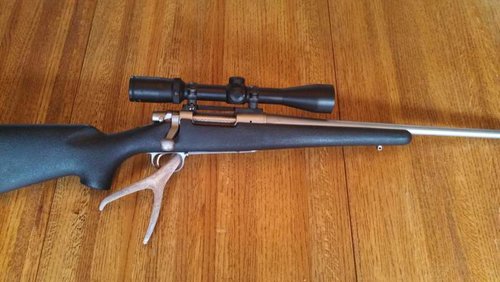
The scope size seemed out of proportion to the rifle, and it needed a scope of its' own anyway, so I decided to go with a Leupold VXII 2-7x33 with CDS. Here it is now:
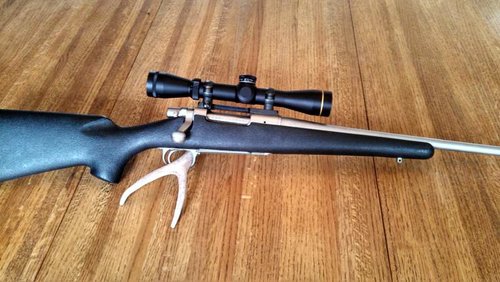
And here's a pic to show the difference in proportion between the two:
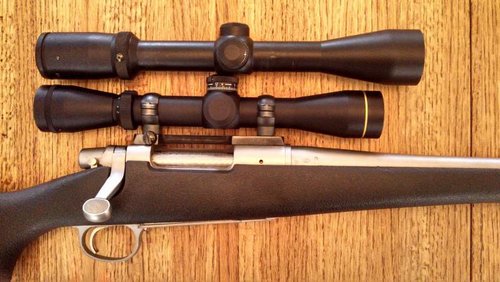
I think that little Leupold it a great fit. Seven power should be plenty of magnification for our needs, and the eye relief/eye box is very generous.
So that's where I stand now, but I have a question about my next step. I'd like to mount the scope lower down to the bore. The easiest thing to do would be to get a set of Leupolds' standard low-height rings-- those are mediums on it now-- but I'd like to go to a two piece base. I've been eyeing a set of Talley Lightweights. Any thoughts on these rings? Pros and cons? Is there another brand that I should check out?
On to how it shoots... results have varied...
140gr bullets proved accurate, but a little slower than I liked-- the rifle has a 20 inch barrel-- so I tried some 129gr Interlocks that I got through the Hunt Talk bullet exchange. Initial ladder testing went like this:
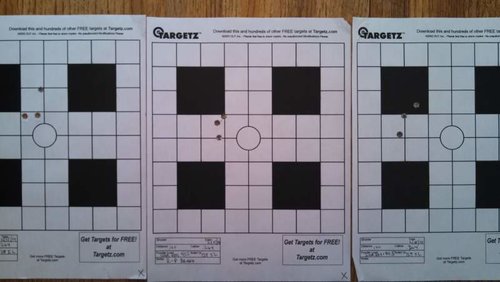
You won't hear me complaining about that...
Due to availability, I tried a different brand of brass, and had similar results. The most accurate load with both brands of brass had the same powder weight charge-- here are the groups together.
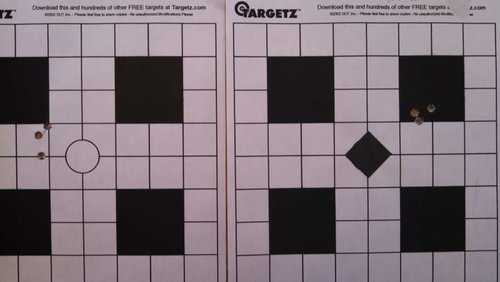
So far so good, but it was just a sample size of two groups, so I did some more testing. On separate days, I fired a four round group and a five round group. Here's what happened:
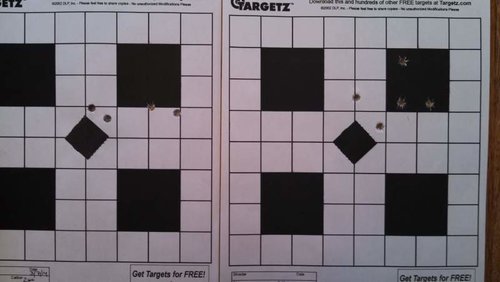
Since I hadn't changed anything with the rifle or load, my head is screaming "operator error." So here's the question:
For those of you with experience with a variety of rifles, have you noticed that a lightweight rifle magnifies any inconsistencies in shooting form? Are they just harder to shoot consistently well? I'm thinking that I really need to settle down and pay attention to every little bit of my form. The rifle would certainly benefit from a trigger job, and bedding the action and free-floating the barrel are long-term ideas, but I figured that I should fix myself first, and be prepared to coach my son on how to shoot the rifle.
Any thoughts and advice are appreciated...
The first thing I did was to mount an old scope on it to test some loads to see if it would shoot. Here it is with a Burris 3-9x40:

The scope size seemed out of proportion to the rifle, and it needed a scope of its' own anyway, so I decided to go with a Leupold VXII 2-7x33 with CDS. Here it is now:

And here's a pic to show the difference in proportion between the two:

I think that little Leupold it a great fit. Seven power should be plenty of magnification for our needs, and the eye relief/eye box is very generous.
So that's where I stand now, but I have a question about my next step. I'd like to mount the scope lower down to the bore. The easiest thing to do would be to get a set of Leupolds' standard low-height rings-- those are mediums on it now-- but I'd like to go to a two piece base. I've been eyeing a set of Talley Lightweights. Any thoughts on these rings? Pros and cons? Is there another brand that I should check out?
On to how it shoots... results have varied...
140gr bullets proved accurate, but a little slower than I liked-- the rifle has a 20 inch barrel-- so I tried some 129gr Interlocks that I got through the Hunt Talk bullet exchange. Initial ladder testing went like this:

You won't hear me complaining about that...
Due to availability, I tried a different brand of brass, and had similar results. The most accurate load with both brands of brass had the same powder weight charge-- here are the groups together.

So far so good, but it was just a sample size of two groups, so I did some more testing. On separate days, I fired a four round group and a five round group. Here's what happened:

Since I hadn't changed anything with the rifle or load, my head is screaming "operator error." So here's the question:
For those of you with experience with a variety of rifles, have you noticed that a lightweight rifle magnifies any inconsistencies in shooting form? Are they just harder to shoot consistently well? I'm thinking that I really need to settle down and pay attention to every little bit of my form. The rifle would certainly benefit from a trigger job, and bedding the action and free-floating the barrel are long-term ideas, but I figured that I should fix myself first, and be prepared to coach my son on how to shoot the rifle.
Any thoughts and advice are appreciated...




